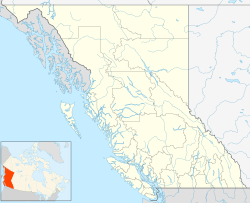Curlew Island (Gulf Islands) facts for kids
| Geography | |
|---|---|
| Location | Strait of Georgia |
| Coordinates | 48°49′49″N 123°14′27″W / 48.83028°N 123.24083°W |
| Archipelago | Gulf Islands |
| Highest elevation | 41 m (135 ft) |
| Administration | |
| Province | British Columbia |
Curlew Island is a small, charming island located in Canada. It's part of a beautiful group of islands known as the Gulf Islands. These islands are found in the Strait of Georgia, a large body of water off the coast of British Columbia. Curlew Island sits right between two other islands, Mayne Island and Samuel Island. People believe it was named after an old British ship called HMS Curlew.
Contents
Exploring Curlew Island: A Tiny Canadian Gem
Curlew Island might be small, but it's a fascinating part of Canada's west coast. It's one of many islands that dot the waters of the Strait of Georgia. This island is located in the southern part of the Gulf Islands. It's a great example of the many natural wonders found in British Columbia.
Where is Curlew Island Located?
Curlew Island is in British Columbia, Canada's westernmost province. It's part of the Gulf Islands, which are a chain of islands. These islands are nestled in the Strait of Georgia. This strait is a large channel of water between Vancouver Island and the mainland of British Columbia. Curlew Island is specifically found between Mayne Island and Samuel Island.
What is the Strait of Georgia?
The Strait of Georgia is a big body of water. It connects to the Pacific Ocean. Many islands, including Curlew Island, are found here. The strait is home to lots of marine life. It's also a busy waterway for boats and ferries. It's an important part of the local ecosystem.
How High is Curlew Island?
Curlew Island is not very tall. Its highest point is about 41 meters (135 feet) above sea level. To give you an idea, that's roughly the height of a 13-story building. This elevation makes it a small but noticeable feature in the landscape. It stands out among the other islands in the area.
Many places in British Columbia were named after ships or important people. Curlew Island is no different. It is believed to be named after a British ship. This ship was called HMS Curlew.
Who Was HMS Curlew?
HMS Curlew was a British Royal Navy ship. It was a sloop, which is a type of warship. This particular HMS Curlew was launched in 1854. Ships like the Curlew often explored new areas. They also helped map coastlines. This was very important for navigation and trade. Naming an island after such a ship was a common practice. It honored the ship's role in exploring the region.
The Gulf Islands: A Special Place
Curlew Island is part of the larger Gulf Islands archipelago. An archipelago is a group of islands. The Gulf Islands are known for their natural beauty. They have a mild climate, which means they don't get too hot or too cold.
What Makes the Gulf Islands Unique?
The Gulf Islands are famous for their beautiful scenery. They have rocky shorelines and lush forests. Many different types of plants and animals live here. The islands are also popular for outdoor activities. People enjoy kayaking, hiking, and wildlife watching. Each island has its own unique charm.
Wildlife Around Curlew Island
Even small islands like Curlew Island are home to wildlife. You might see various birds flying overhead. Marine animals like seals and sea lions often swim in the nearby waters. The Strait of Georgia is also home to different types of fish. It's a rich environment for many creatures.
Why Are Small Islands Important?
Small islands like Curlew Island play a role in the environment. They can be important habitats for animals. They also contribute to the overall beauty of the region. Studying these islands helps us understand local geography. It also teaches us about the history of exploration.
Learning About Geography
Looking at Curlew Island helps us learn about geography. We can see how landforms are created. We can also understand how islands fit into larger ecosystems. It shows us how different parts of the world are connected. Every island, big or small, has a story to tell.


